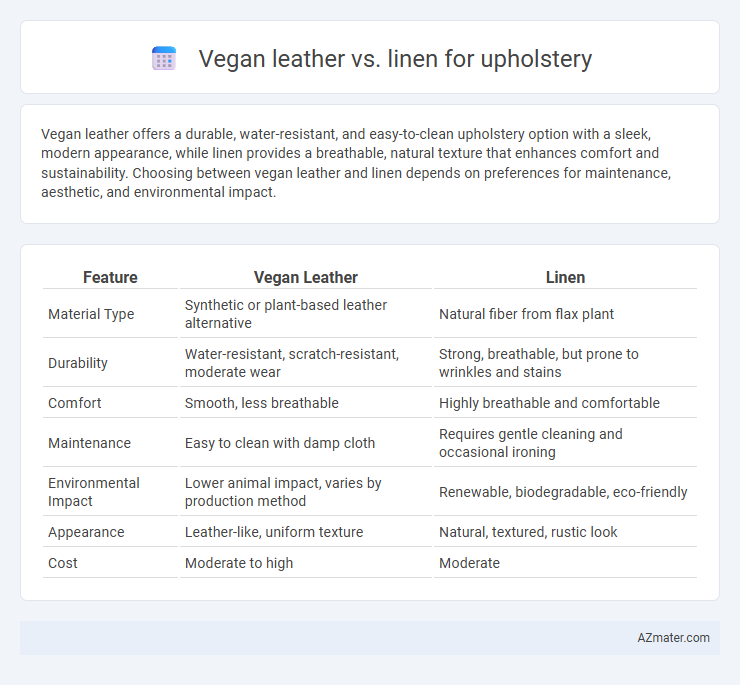Vegan leather offers a durable, water-resistant, and easy-to-clean upholstery option with a sleek, modern appearance, while linen provides a breathable, natural texture that enhances comfort and sustainability. Choosing between vegan leather and linen depends on preferences for maintenance, aesthetic, and environmental impact.
Table of Comparison
| Feature | Vegan Leather | Linen |
|---|---|---|
| Material Type | Synthetic or plant-based leather alternative | Natural fiber from flax plant |
| Durability | Water-resistant, scratch-resistant, moderate wear | Strong, breathable, but prone to wrinkles and stains |
| Comfort | Smooth, less breathable | Highly breathable and comfortable |
| Maintenance | Easy to clean with damp cloth | Requires gentle cleaning and occasional ironing |
| Environmental Impact | Lower animal impact, varies by production method | Renewable, biodegradable, eco-friendly |
| Appearance | Leather-like, uniform texture | Natural, textured, rustic look |
| Cost | Moderate to high | Moderate |
Introduction to Vegan Leather and Linen Upholstery
Vegan leather, a sustainable alternative made from synthetic or plant-based materials, offers durability and easy maintenance for upholstery, mimicking the look and feel of traditional leather without animal products. Linen upholstery, derived from flax fibers, is valued for its natural breathability, eco-friendliness, and classic texture, providing a lightweight yet strong fabric choice. Both materials cater to eco-conscious consumers seeking stylish, cruelty-free options with distinct aesthetic and functional benefits in furniture design.
Material Composition and Sourcing
Vegan leather, typically made from polyurethane or plant-based materials such as pineapple leaves or apple peels, offers a synthetic yet animal-friendly alternative with varied environmental impacts depending on production methods. Linen, derived from the flax plant, provides a natural, biodegradable fabric known for breathability and durability, harvested through eco-friendly agricultural practices. Sourcing vegan leather can involve petrochemical processes or agricultural waste, whereas linen relies on sustainable farming and fiber extraction, influencing the overall sustainability of upholstery materials.
Environmental Impact Comparison
Vegan leather, often made from polyurethane or plant-based materials like pineapple leaves or cactus, offers a synthetic alternative to animal leather but can involve energy-intensive production and limited biodegradability, impacting its environmental footprint. Linen, derived from flax plants, is a natural fiber known for its low water usage, minimal pesticide requirements, and full biodegradability, making it a highly sustainable choice for upholstery. Comparing both, linen typically presents a lower environmental impact due to its renewable source and compostability, whereas vegan leather's sustainability depends heavily on the specific material and manufacturing process used.
Durability and Longevity
Vegan leather offers high durability with resistance to stains and easy maintenance, making it ideal for long-term upholstery use, while linen provides natural breathability and strength but may wear faster under heavy use. Linen's fibers can degrade over time with exposure to sunlight and friction, whereas vegan leather maintains structural integrity longer despite physical stress. Choosing between vegan leather and linen depends on the desired balance between synthetic resilience and organic texture for upholstery applications.
Comfort and Texture Differences
Vegan leather offers a smooth, sleek texture with moderate breathability, providing easy-to-clean surfaces ideal for modern upholstery but may feel less plush than natural fabrics. Linen boasts a soft, breathable weave that enhances comfort by allowing better air circulation, reducing heat buildup and creating a cozy seating experience. While vegan leather replicates traditional leather's appearance with added durability, linen delivers a natural, textured feel that appeals to those valuing tactile softness and environmental sustainability.
Maintenance and Cleaning Requirements
Vegan leather offers easy maintenance with simple wiping using a damp cloth and mild soap, making it resistant to stains and spills. Linen upholstery requires more frequent cleaning as it absorbs dirt and oils, often needing professional cleaning or gentle machine washing to maintain its texture and color. Both materials benefit from regular dusting but vegan leather generally offers superior durability and moisture resistance in maintenance.
Aesthetic Options and Versatility
Vegan leather offers a sleek, modern aesthetic with a wide range of color and texture options, making it ideal for contemporary upholstery designs. Linen provides a natural, breathable texture with a timeless appeal, available in numerous weaves and shades that suit both casual and formal settings. The versatility of vegan leather lies in its durability and stain resistance, while linen excels in comfort and breathability, allowing diverse design applications from minimalist to rustic styles.
Cost and Affordability Analysis
Vegan leather offers a sleek, durable finish for upholstery but tends to have higher upfront costs due to synthetic production processes, while linen provides a more affordable, breathable natural fabric with lower initial investment but may require more frequent maintenance or replacement. The price difference can vary widely based on quality and brand, with premium vegan leather costing up to 50% more than standard linen options. Budget-conscious consumers prioritizing longevity and eco-friendliness may find linen more cost-effective, whereas those seeking a modern aesthetic and easier cleaning often opt for vegan leather despite the higher price point.
Allergy-Friendliness and Health Considerations
Vegan leather offers a hypoallergenic surface less likely to harbor dust mites and allergens, making it suitable for allergy sufferers. Linen, a natural fiber, is breathable and resistant to bacteria but can attract dust and requires regular cleaning to maintain its allergen-free properties. Choosing between vegan leather and linen for upholstery should consider individual sensitivities, with vegan leather often preferred for improved allergy-friendliness and easier maintenance.
Suitability for Different Interior Styles
Vegan leather offers a sleek, modern aesthetic ideal for contemporary and minimalist interior styles, providing durability and easy maintenance. Linen upholstery brings a natural, textured look that suits rustic, coastal, and Scandinavian designs, enhancing warmth and comfort. Both materials complement diverse decor, with vegan leather favoring polished environments and linen thriving in relaxed, organic settings.

Infographic: Vegan leather vs Linen for Upholstery
 azmater.com
azmater.com